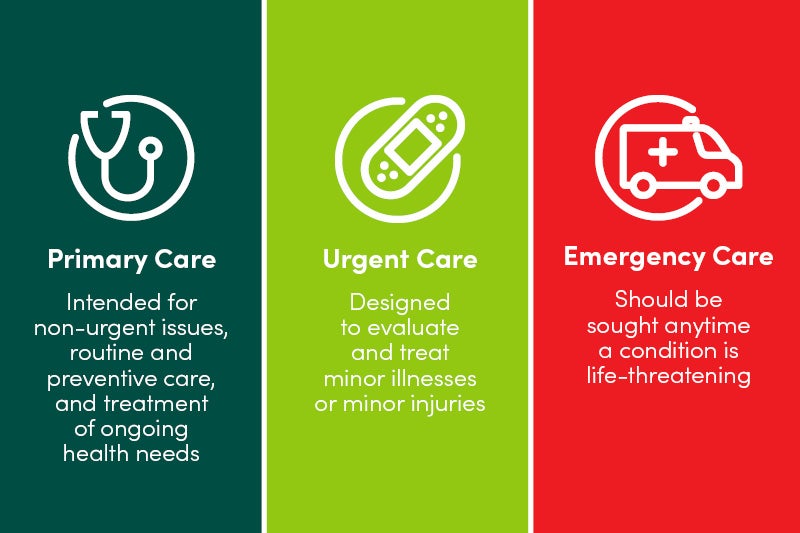Primary care vs. urgent care vs. emergency care: Where should I go?
July 8, 2025Categories: Wellness

Overview: Primary care vs. urgent care vs. emergency care, when should I go where? Are they all the same? Understanding the difference between these care options can help you make the right choice, so you or your loved one receives the best possible care.
Visiting your doctor, going to urgent care and heading to the emergency department can all seem similar, but choosing the right location is important in getting the care you need.
When to visit your doctor's office
You should see your primary care provider (PCP) for routine and non-urgent medical care. Your PCP partners with you to manage your overall health and serves as your first point of contact for your health care needs.
Visit your doctor's office for:
- Routine well visits
- Preventative care
- Immunizations or shots
- Chronic Care Management (diabetes, blood pressure)
- Rashes
- Cold and flu symptoms
- Gastrointestinal issues
- Minor injuries (sprains and strains)
- Sore throat
- Pink eye
- Lower back pain
- Animal or insect bite
- Urinary tract infection
- Pelvic wellness
- Ear pain
MercyOne Primary Care location near you
When to visit urgent care
Urgent care is best for non-life-threatening issues that need immediate attention. Urgent care clinics often have evening and weekend hours when your primary care provider may not be available. And many accept walk-ins, making them a convenient option for timely care.
However, urgent care should not replace your PCP. If you visit urgent care for a condition that requires ongoing monitoring or referral to a specialist, it’s important to follow up with your PCP.
Visit an urgent care clinic for:
- Injuries
- Lacerations/stiches
- Rashes
- cold and flue symptoms
- Sore throat
- Pink eye
- Lower back pain
- Animal or insect bite
- Urinary tract infection
- Ear pain
Find a MercyOne Urgent Care clinic
When to visit an emergency department
For serious injuries or severe illness that may require hospitalization, head to the emergency department (ED). For any life-threatening emergency, call 911.
Unlike primary care or urgent care, the ED is open 24/7 and can handle a wide range of emergencies. While the ED is appropriate for acute care, it’s not for routine or non-urgent medical issues. Visiting the ED for minor conditions can lead to long wait times, higher medical costs and may take resources away from patients with true health emergencies.
Visit the emergency department for:
- Severe allergic reactions
- Infants needing immediate care
- Infants with a fever less than 2 months old
- Chest pain
- Severe burns
- Seizures
- Serious eye or head injuries
- Stroke symptoms
- Severe abdominal pain
- Broken bones
- Rapid bleeding
- Heart attack symptoms
- High fevers
- Breathing problems
- Drug overdose or poisoning
- Bad falls (for older adults)
MercyOne Emergency Care locations
Find the care you need, where you need it
Knowing where to go when you’re experiencing a health issue helps you get the right care at the right time and can impact your overall health. Understanding your different care options, PCP vs. urgent care vs. ED, can help you make the right choice when it matters most.
This blog was medically reviewed by a MercyOne Provider
